The AMD Radeon R9 Nano Review: The Power of Size
by Ryan Smith on September 10, 2015 8:00 AM ESTCompute
Shifting gears, we have our look at compute performance.
Starting us off for our look at compute is LuxMark3.0, the latest version of the official benchmark of LuxRender 2.0. LuxRender’s GPU-accelerated rendering mode is an OpenCL based ray tracer that forms a part of the larger LuxRender suite. Ray tracing has become a stronghold for GPUs in recent years as ray tracing maps well to GPU pipelines, allowing artists to render scenes much more quickly than with CPUs alone.
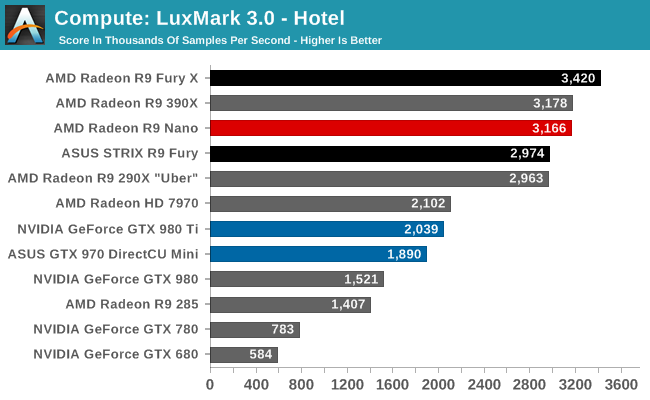
LuxMark ends up being a great corner case for where having a fully enabled Fiji GPU is more important than having the highest clockspeeds. With the R9 Nano able to flirt with its full 1000MHz clockspeed here, the card is able to pass the R9 Fury here. The only thing stopping it from taking the second-place spot is the R9 390X, as Hawaii still sees strong performance here even with fewer SPs.
For our second set of compute benchmarks we have CompuBench 1.5, the successor to CLBenchmark. CompuBench offers a wide array of different practical compute workloads, and we’ve decided to focus on face detection, optical flow modeling, and particle simulations.
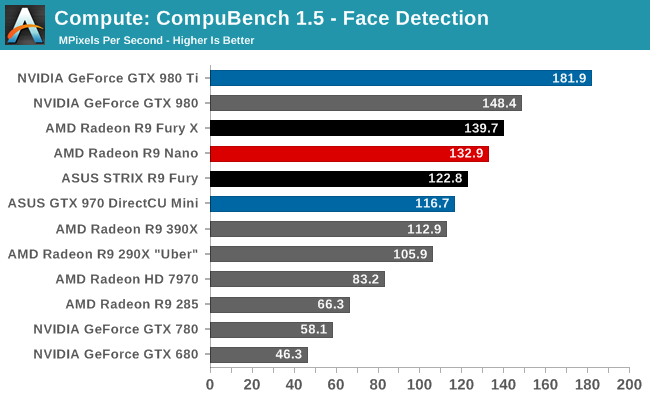
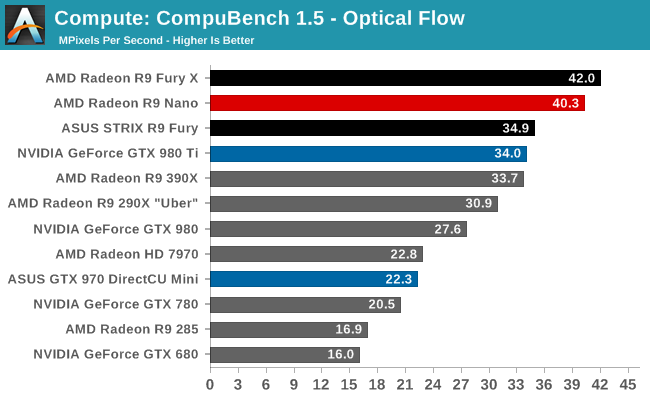
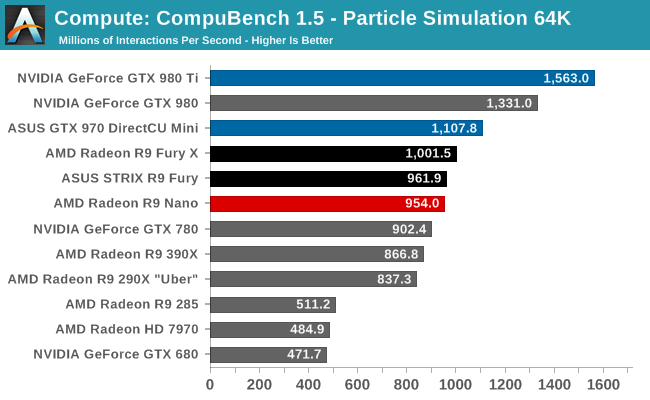
CompuBench provides us another case of where the R9 Nano ends up outpacing the R9 Fury. As a result AMD’s latest card tends to perform somewhere between an R9 Fury and R9 Fury X, with all of the strengths and weaknesses that come from that. This puts the R9 Nano in a good place for Optical Flow, while it will still trail NVIDIA”s best cards under Face Detection and the 64K particle simulation.
Meanwhile it’s interesting to note that AMD’s particle sim scores have significantly improved in the recent drivers. GCN 1.2 cards have seen 20%+ performance improvements here, which may point to some new OpenCL compiler optimizations from AMD.
Our 3rd compute benchmark is Sony Vegas Pro 13, an OpenGL and OpenCL video editing and authoring package. Vegas can use GPUs in a few different ways, the primary uses being to accelerate the video effects and compositing process itself, and in the video encoding step. With video encoding being increasingly offloaded to dedicated DSPs these days we’re focusing on the editing and compositing process, rendering to a low CPU overhead format (XDCAM EX). This specific test comes from Sony, and measures how long it takes to render a video.
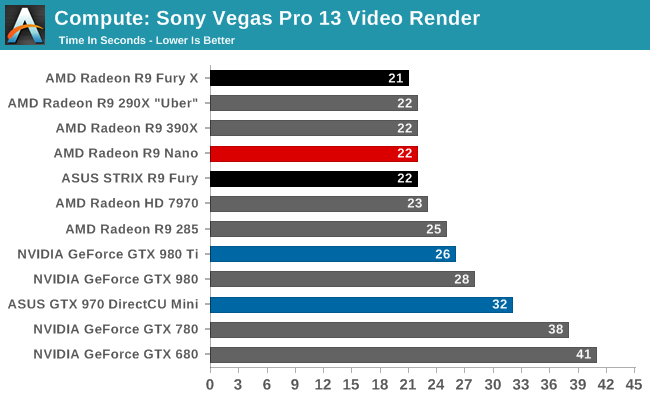
With Vegas there are no surprises; the R9 Nano ties the R9 Fury.
Moving on, our 4th compute benchmark is FAHBench, the official Folding @ Home benchmark. Folding @ Home is the popular Stanford-backed research and distributed computing initiative that has work distributed to millions of volunteer computers over the internet, each of which is responsible for a tiny slice of a protein folding simulation. FAHBench can test both single precision and double precision floating point performance, with single precision being the most useful metric for most consumer cards due to their low double precision performance. Each precision has two modes, explicit and implicit, the difference being whether water atoms are included in the simulation, which adds quite a bit of work and overhead. This is another OpenCL test, utilizing the OpenCL path for FAHCore 17.

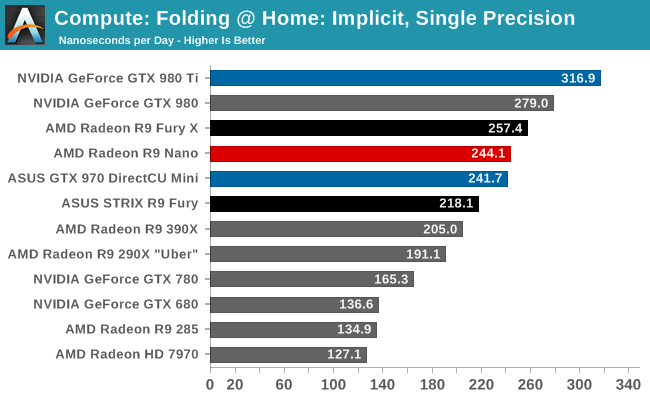
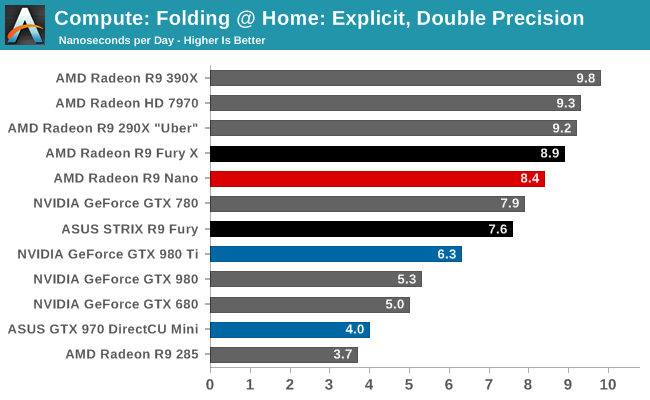
Much like CompuBench and LuxMark, the R9 Nano punches above its weight here. The lack of a graphics workload – and resulting demands on graphics hardware like the ROPs – means most of the card’s power can be allocated to the shaders, allowing higher clockspeeds. This gives the Nano a boost in this situation to bring it much closer to the Fury X, though as far as Folding goes AMD will still trail NVIDIA’s best cards.
Wrapping things up, our final compute benchmark is an in-house project developed by our very own Dr. Ian Cutress. SystemCompute is our first C++ AMP benchmark, utilizing Microsoft’s simple C++ extensions to allow the easy use of GPU computing in C++ programs. SystemCompute in turn is a collection of benchmarks for several different fundamental compute algorithms, with the final score represented in points. DirectCompute is the compute backend for C++ AMP on Windows, so this forms our other DirectCompute test.

Our final test sees the R9 Nano brought back to its place behind the R9 Fury, as the C++ AMP sub-tests are strenuous enough to cause more significant clockspeed throttling. Even behind the R9 Fury the R9 Nano does well for itself here, coming in behind the GTX 980 Ti and head of the R9 390X and GTX 980.










284 Comments
View All Comments
looncraz - Thursday, September 10, 2015 - link
Indeed. At $200 cheaper I'd consider buying two of them, rather than none.The lack of a DL-DVI port, though, would probably limit me to just one.
Alexvrb - Saturday, September 12, 2015 - link
Agreed I think it's a great compact card but for their sake I hope they drop the price gradually as yields improve. Personally I will be waiting to see what happens with HBM2, I'm hoping that with the improvements in density they'll be able to push it into mid-range cards as well next time.Oxford Guy - Thursday, September 10, 2015 - link
I didn't see much about DX 12 and how it should counter all the energy efficiency stuff that is being pretty much obsessed about. The conclusion, for instance, talks so much about energy efficiency when in fact the real point of this card is not performance per watt but the form factor.I don't see anything about Ashes — not even a word about why it wasn't included.
Ryan Smith - Thursday, September 10, 2015 - link
"I don't see anything about Ashes — not even a word about why it wasn't included."We don't include non-release software in our GPU evaluations. Ashes isn't a complete game, it's still an alpha.
AS118 - Thursday, September 10, 2015 - link
I feel like that's totally valid. Until multiple finalized DX12 benches come out, I don't feel that we can really understand how current cards will work with DX12.Oxford Guy - Friday, September 11, 2015 - link
It still merits a mention, even if it's just to say that.AS118 - Thursday, September 10, 2015 - link
I agree. In fact, this review seems as honest as every other Nano one. They all say "it's niche" and "it's too expensive for the performance if you don't need the small size, and regardless of what Roy said, the sites that were given a card are quite critical of the Nano, and most recommend getting a bigger, faster, cheaper card instead if you don't need something tiny.They say "It's a great product, but only for people that really must have the strongest mini-card".
RussianSensation - Thursday, September 10, 2015 - link
Wreckage = trolls like Rollo, but minus the facts.Kutark - Thursday, September 10, 2015 - link
Whats the Roy Taylor incident? Im not aware.at80eighty - Friday, September 11, 2015 - link
If there's anyone championing the cause of objectivity, it's you